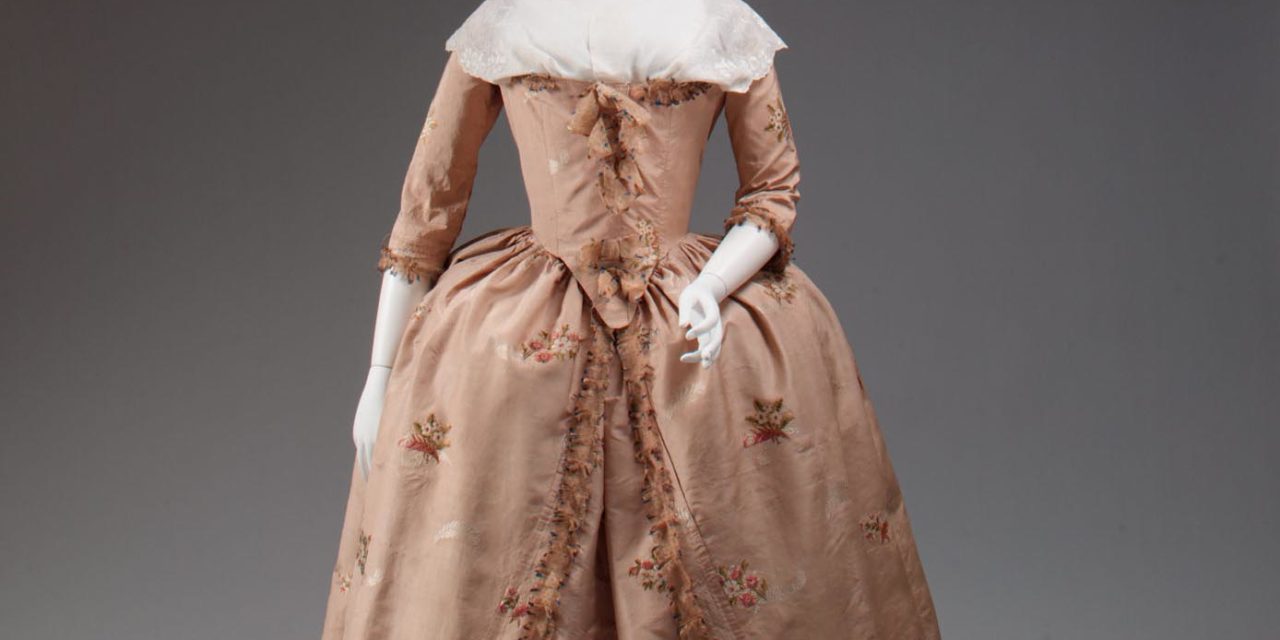The 18th-century robe à l’anglaise consisted of a fitted bodice cut in one piece with an overskirt that was often parted in front to reveal the petticoat.
The Details
T
he Fairchild Dictionary of Fashion (2003) defines a robe à l’anglaise as a:
“Dress, close-fitting in both front and back, that was worn in the late 18th century without panniers. The bodice was shaped to long point in back and closed in front. Skirt was either closed or slashed in front to show matching petticoat. ‘English Gown’ in French” (Calasibetta 214)
According to Marnie Fogg in Fashion: The Whole Story (2013):
“The robe à l’anglaise reflects late 18th century propensity for anglomania and prevalent elite interest in the idealized natural world. Never formal enough to be an official court gown, it was worn in aristocratic salons and upper-class daily life.” (100)
Fogg goes on to describe the garment in detail, while also explaining how it changed the female body of the time,
“The single-piece, front-fastening robe worn from 1770 changed the female silhouette completely. Pleats are sewn into the skirt just below the deep “V” shaped waistline, adding volume to the back of the dress and narrowing the hips. The robe is rendered comfortable by removing excessive boning and panniers, and tight stomachers are replaced by comperes, made of matching fabric. These two panels are a little less restrictive than a corset, attached by buttons or hooks at the front opening of the dress, and adjustable at the back…. Sleeves are simplified streamlined, and less extravagantly trimmed, and narrowed to the elbow before widening out from a horizontal seam.” (100)
Wikipedia describes the origin and construction of the robe à l’anglaise:
“Like the earlier mantua, from which it evolved, the back of the gown featured pleats from the shoulder, stitched down to mould the gown closely to the body until the fullness was released into the skirt. Through the 1770s, the back pleats became narrower and closer to the center back, and by the 1780s these pleats had mostly disappeared and the skirt and bodice were cut separately. The gown was open in front, to reveal a matching or contrasting petticoat, and featured elbow-length sleeves, which were finished with separate frills called engageantes.”
Fig. 1 - Designer unknown (British). Robe à l'Anglaise, 1776. Silk. New York: Metropolitan Museum of Art, 2009.300.952. Brooklyn Museum Costume Collection at The Metropolitan Museum of Art, Gift of the Brooklyn Museum, 2009; H. Randolph Lever Fund, 1973. Source: The Met
Fig. 2 - Designer unknown (American or European). Robe à l'Anglaise, ca. 1770. Silk. New York: Metropolitan Museum of Art, C.I.37.66a, b. Gift of Irene Lewisohn, 1937. Source: The Met
Fig. 3 - Designer unknown (French). Robe à l'Anglaise, 1784–87. Cotton, metal, silk. New York: Metropolitan Museum of Art, 1991.204a, b. Purchase, Isabel Shults Fund and Irene Lewisohn Bequest, 1991. Source: The Met
Fig. 4 - Designer unknown (United States, North and Central America). Woman's dress (Robe à l'anglaise) with Zone Front, ca. 1785-1793. Indian export fine cotton plain weave with silver foil embroidery in stem and satin stitches; silk satin; sized fine cotton plain weave; center back length: 154.9 cm, waist: 55.9 cm (center back length: 61 inches, waist: 22 inches). Philadelphia: Philadelphia Museum of Art, 1955-98-9. Gift of Thomas Francis Cadwalader, 1955. Source: Philadelphia Museum
Fig. 5 - Élisabeth-Louise Vigée-Lebrun (French, 1755-1842). Marie Antoinette holding a rose by Élisabeth-Louise Vigée-Lebrun (Versailles), 1783. Source: Grand Ladies
Its Afterlife
The robe à l’anglaise was a very popular garment in the 18th century worn even by royals like Marie Antoinette despite its informality (Fig. 5).
The robe à l’anglaise still inspires fashions on the runway today, as seen in looks by Vivienne Westwood and Thierry Mugler (Figs. 6-7).
Fig. 6 - Vivienne Westwood (British, 1941-). Collection “Les Femmes”, S/S 1996. Source: Pinterest
Fig. 7 - Thierry Mugler (French, 1948-). Haute Couture F/W 1997/1998. Source: Pinterest
References:
- Calasibetta, Charlotte Mankey, Phyllis G. Tortora, Charlotte Mankey Calasibetta, and Publications Fairchild. The Fairchild Dictionary of Fashion. 3rd ed. New York: Fairchild Publications, 2003. http://www.worldcat.org/oclc/904557113.
- “Close-Bodied Gown.” Wikipedia, June 2, 2017. https://en.wikipedia.org/w/index.php?title=Close-bodied_gown&oldid=783480910.
- Fogg, Marnie, ed. Fashion: The Whole Story. New York: Prestel Publishing, a member of Verlagsgruppe Random House GmbH, 2013. http://www.worldcat.org/oclc/855507069.

















